Guinea Pig Leash: Can Guinea Pigs Be Put On A Leash?
Discover simple steps on how to get your pet to wear guinea pig leash for walks outside of its cage. There are several key steps you should follow.
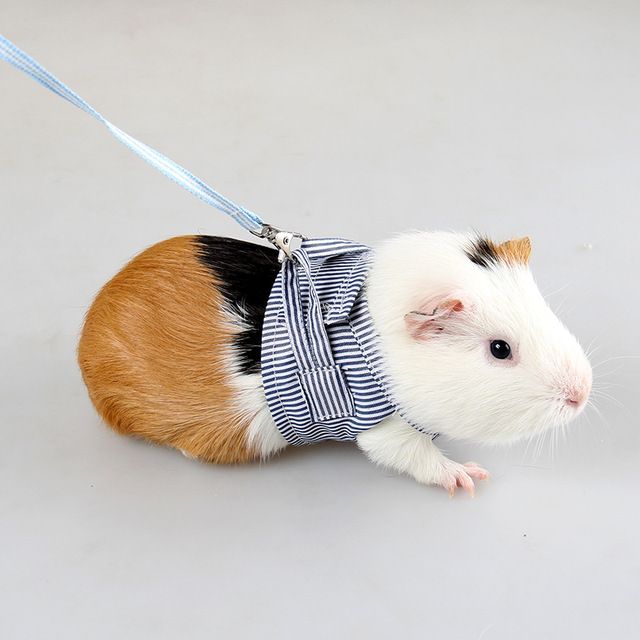
Guinea pigs can be trained to use a leash with practice and patience. However, it is important to understand that not all guinea pigs will take kindly to being on a leash, so this should be done carefully and at the guinea pig’s own pace. Before introducing a guinea pig to the leash, it is important to make sure they are comfortable with being handled and that you set aside time each day for bonding with your piggy.
If your guinea pigs appear to be uninterested or uncomfortable with being on a leash, do not force them into this situation as it can lead to further stress. There are other ways to provide exercise, such as supervised playtime or indoor enclosures, which are safer for your guinea pig’s well-being.
In general, it isn’t recommended to put guinea pigs on leashes because they are prey animals by nature and may become easily frightened when in an unfamiliar environment or around larger creatures like people. Guinea pigs have very fragile necks, and their spines aren’t as flexible as other small animals. A guinea pig's anatomy makes them especially vulnerable to injury. Even a bit of force or stress can be harmful to guinea pigs. You may underestimate your strength and pull on the leash too hard, leading to serious injuries. Additionally, their delicate legs may cause injury if pulled too hard while on a leash.
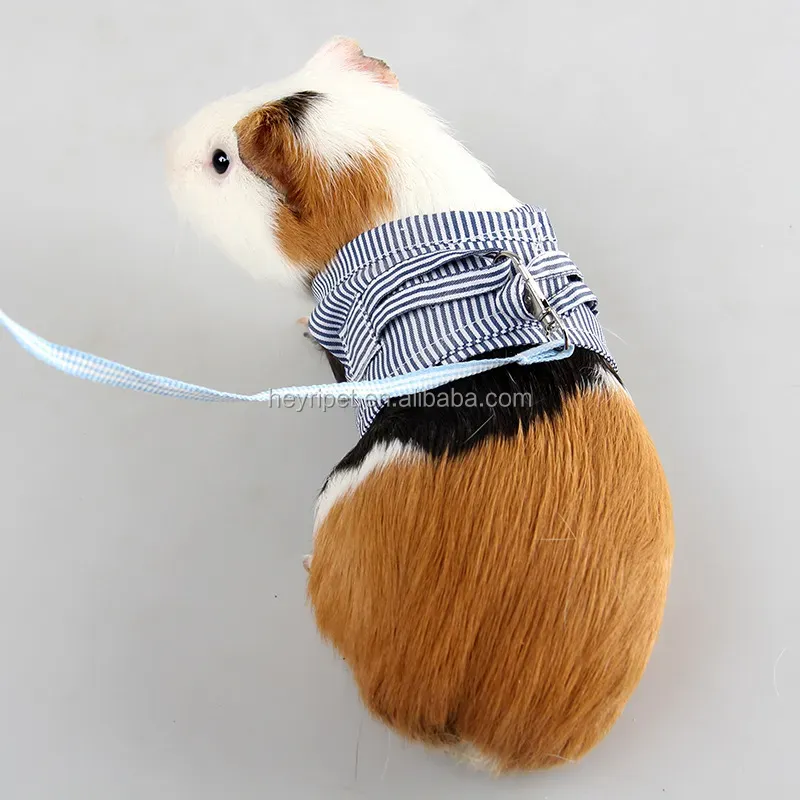
Leashes are bad for guinea pigs due to the risk of injury and stress. There’s also the chance that while on a leash, your guinea pig will be scared or startled by something and try to run away, which can cause harm to their neck if you’re holding the leash too firmly. Injuries can occur or happen if the guinea pig is pulled or tries to escape. Leashes, harnesses and collars also can just cause a lot of stress for your guinea pig in general. Too much stress is never good for your guinea pig’s overall health, because it also weakens their immune system and makes them susceptible to illnesses. Guinea pigs are better carried or allowed to walk freely in a safe enclosure rather than being walked on a leash.
Introduction to Leash Training
Leash training a guinea pig is not as straightforward as it might seem for other small pets. Guinea pigs are gentle, sensitive animals with unique needs, and most guinea pigs are not naturally suited to walking on a leash like a dog or even a ferret. For guinea pig owners, it’s important to recognize that putting your pig on a leash can be stressful for them, and not every guinea pig will enjoy or tolerate this kind of activity.
When considering leash training, always prioritize your guinea pig’s comfort and safety. Guinea pigs cool down quickly and are susceptible to changes in temperature, so avoid exposing them to too much heat or damp grass, which can make them uncomfortable or even ill. Instead, focus on providing guinea pig exercises that allow your pet to play and explore in a secure, temperature-controlled environment. Training should be slow and gentle, with plenty of positive reinforcement, and always tailored to your guinea pig’s individual personality and needs. Remember, the goal is to enrich your guinea pig’s life, not to cause unnecessary stress or risk.
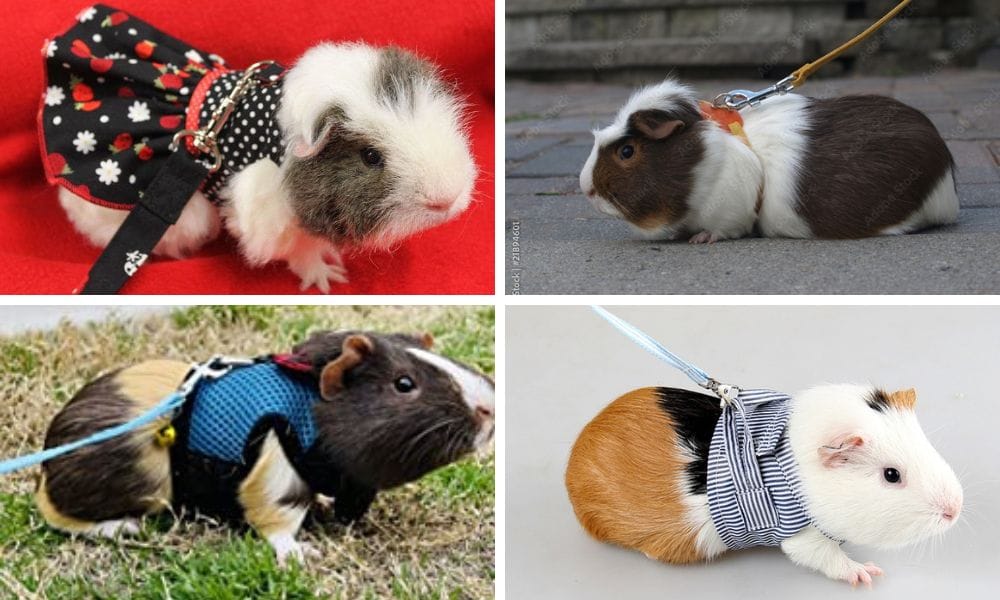
Risks and Considerations
While the idea of walking your guinea pig on a leash might sound fun, it’s important to understand the risks involved. Guinea pigs have delicate spines and fragile bodies, making them much more vulnerable to injury than other small animals. Using a leash can be a bad idea if not done with extreme care, as even a gentle tug can cause harm to your pig’s back or neck. Leashes and harnesses can also be dangerous if your guinea pig gets tangled, pulled, or tries to escape suddenly.
Another major concern is the environment. Many common plants found in yards and parks are poisonous to guinea pigs, and even a small nibble can be harmful or fatal. Always check the area for poisonous plants and other hazards before letting your guinea pig explore. Never leave your guinea pig unattended outside, as they can quickly become prey for predators like cats, dogs, or birds, or escape through small gaps.
Heat stroke is another serious risk, especially during warmer months. Guinea pigs can overheat easily, so always provide food and water during exercise or playtime, and avoid walking them in direct sunlight or on hot days. Remember, leashes are not designed for guinea pigs and other small animals, and the risks often outweigh the benefits. Always put your guinea pig’s safety and well-being first.
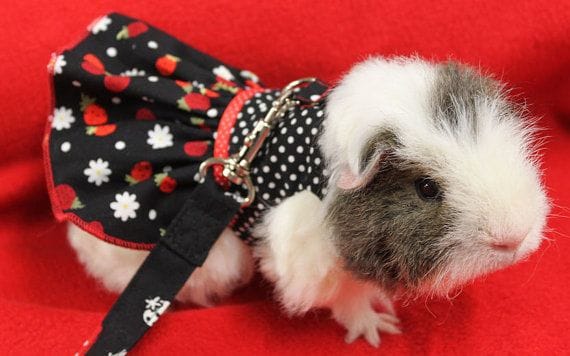
Preparing for Training
Before you even think about putting a leash on your guinea pig, preparation is key. Start by ensuring your guinea pig has a bigger cage or enclosure that allows for plenty of exercise and play. A spacious, safe environment is essential for your pig’s physical and mental health, and can often provide all the exercise they need without the risks of outdoor walks.
If you do decide to try leash training, make sure the area is free from hazardous materials like chemicals, poisonous plants, or other dangers that could harm your guinea pig. Always use a harness specifically designed for small animals such as guinea pigs, hamsters, or ferrets—never a collar, as it can put dangerous pressure on your pig’s neck and spine. Follow the manufacturer’s instructions carefully to ensure a proper fit and minimize the risk of escape or injury.
Guinea pig owners should also be aware of the stress that new experiences can cause. Take things slowly, and watch for signs of discomfort or anxiety in your pet. By preparing a safe enclosure, choosing the right harness, and being mindful of potential hazards, you can help make leash training a safer and more enjoyable experience for both you and your guinea pig.
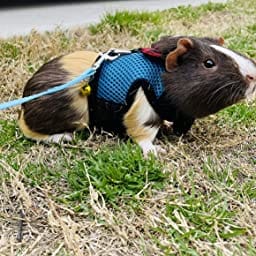
How to train your piggy to wear a harness
Guinea pigs love exploring! So the playing indoor or in a playpen won’t satisfy their desire to experience new things. Providing a bit more variation in activities, such as tunnels, toys, and supervised floor time, can help keep your piggies engaged and happy. However, when taking your guinea pigs for a walk outside you have to be very cautious of the hazards, that is where leash or guinea pig harness comes in handy.
If you decide that you would like your pet guinea pig to wear a guinea pig harness for walks outside of its cage then there are several key steps you should follow:
1) Start off using a small harness indoors so your pet can get comfortable with wearing it before venturing outside. Begin slowly at first - allow your pet out onto the floor without attaching the lead until they start walking around comfortably while wearing the harness; this could take multiple days depending on how quickly they adapt but don’t rush them as this experience must remain positive! Some piggies may have trouble adjusting to the harness, so be patient and gentle.
2) Once they’ve gotten used to their new outfit inside the home, try taking them outdoors where there aren’t large crowds of people or other animals which could make them feel threatened. Go somewhere quiet such as a backyard or park where there is plenty of space for them run free if need be. A fenced yard is ideal for safe exploration and to protect your piggies from hazards.
3) Attach both ends of the lead securely and set off for short walks together completing only one direction at any given time - pick up when necessary as you do not want your furry friend’s legs getting caught between bricks etc from sudden movements as these might hurt! Always supervise your guinea pig closely to prevent them from wandering off or getting into unsafe areas.
4) End each walk by rewarding positive behaviour with treats and lavish affection before bringing back home again safely attached in its little outfit once more - remember never leave pets unattended outside!
By following these steps closely whilst executing patience throughout all stages of training, eventually owners will have their lovely pets trotting along beside them hand-in-hand (or paw-in-hand if we’re being literal). Through proper guidance within specific environments too much stress can be avoided whist granting our beloved fluff ones whole new world right at our fingertips! Positive reinforcement and affection will help your buddy feel safe and loved during every adventure.

FAQs
Guinea pig leash: Is it okay to put a guinea pig on a leash?
Yes, it is possible to put a guinea pig on a leash. However, it should only be done with patience and caution as guinea pigs are prey animals and may become easily frightened in unfamiliar environments or around larger creatures like people. It is important to make sure they are comfortable with being handled before introducing them to the leash for walks outside of its cage. It's also important to note that when you put a leash on your guinea pig too loose, there's a chance that they can wriggle out of it and escape, and try to run away. Additionally, asses the area you are planning to walk your guinea pig in: the grass should not be contaminated with pesticides and chemicals; there should be no other animals' waste; the area should be free of the poisonous plants.
How can I walk my guinea pig?
If you decide to walk your guinea pig, there are several key steps you should follow:
- Start by using a small harness indoors so your pet can get comfortable with wearing it before venturing outside. Allow them time to adjust and begin slowly at first.
- Once they've gotten used to the outfit indoors, try taking them outdoors to a quiet place such as a backyard or park.
- Attach both ends of the leash securely and set off for short walks together completing only one direction at any given time.
- End each walk by rewarding positive behaviour with treats and lavish affection before bringing them back home safely attached in its little outfit once more.
With patience, guinea pigs can be taught how to use a leash. However, it is important to understand that not all guinea pigs will take kindly to being on a leash and should not be forced into this situation as it can lead to further stress.
Please keep in mind that having a guinea pig on a leash in a public park can mean loose dogs could attack, loud noises could frighten your pet and the additional exposure to nasty pollutants, things they shouldn't eat (cigarette butts, pesticides, fertilisers etc.) and broken glass etc. could all be harmful.
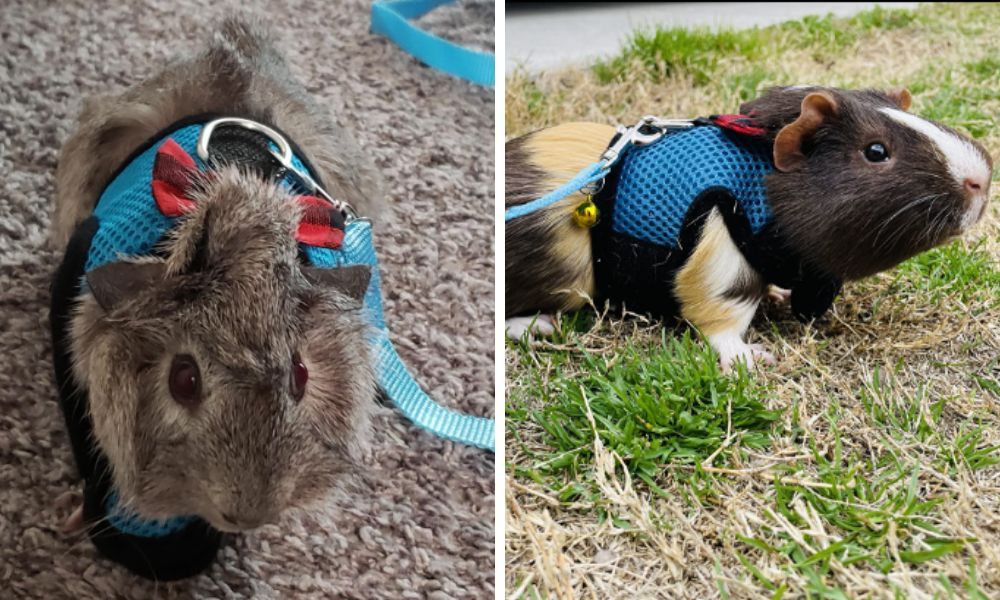
What kind of harness should I get for my guinea pig?
When selecting a harness for your guinea pig, it is important to get one that fits them correctly. The harness should be adjustable so that you can make sure it is not too loose or too tight. Additionally, look for a lightweight harness with a soft material and breathable mesh to ensure your guinea pig's comfort. If possible, opt for a waterproof option as well in case you get caught in the rain while out on a walk.
When picking the right size for your guinea pig, measure around their shoulders and chest to get an idea of what size would fit best. The harness should not be too tight or restrictive but also not too loose that your pet can slip out. Once you have the right size, adjust it accordingly so that it fits snugly yet comfortably against your guinea pig's body. Search for guinea pig accessories and new items on Amazon or in pet shops.
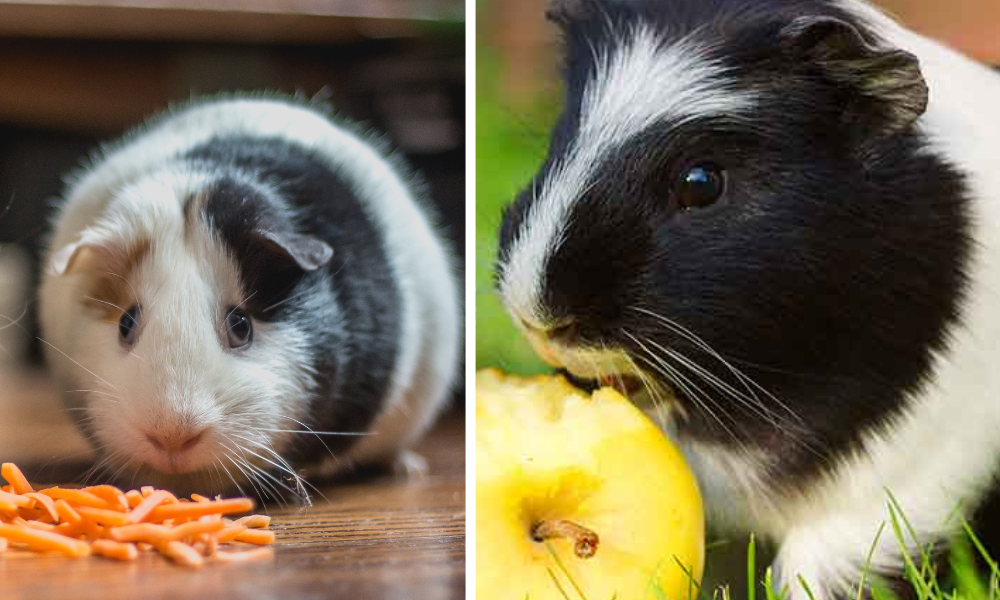
Once you have the right harness, introduce it to your pet gradually in a comfortable environment and reward them with treats so that they associate wearing the harness with something positive. With enough patience and practice, both you and your furry friend can go on lovely walks together! Search for accessories and new items on Amazon or in pet shops.
How not to pick up a guinea pig?
When picking up a guinea pig, it is important to do so in a gentle and caring manner. Never pick them up by the scruff of their neck as this can be uncomfortable and even painful for the animal. Additionally, avoid holding them too tight or restraining their movements as this can cause unnecessary stress.
The best way to pick up your pet is by sliding your hand underneath their body and gently supporting them while lifting. If they feel comfortable enough, you can then cradle the guinea pig in your arms or place them on a soft surface such as a lap or cushion.
It is also important to be mindful of how long you hold them as guinea pigs may become anxious if held for too long.
Can I let my guinea pig walk around the house?
Yes, providing they are wearing a harness and lead. However, it is important to be mindful of potential hazards in your home that your pet could get caught on or in such as small gaps between the sofa or other furniture. Additionally, you should always supervise your guinea pig when out of its cage and pick up if necessary as their legs may get trapped or injured in the process.
If you do choose to let your pet roam around the house, it is important to ensure that any food items, chemicals or other potentially hazardous materials are well out of reach and not accessible by your guinea pig.
At the end...
If you are looking for a new guinea pig leash for your furry friend then you have come to the right place! We have done all the research for you and put together our list of Top 3 leashes you can buy today! Tap the pin to see the list now!

